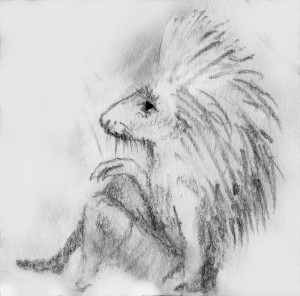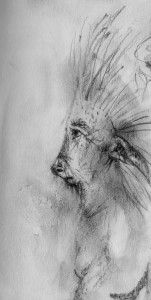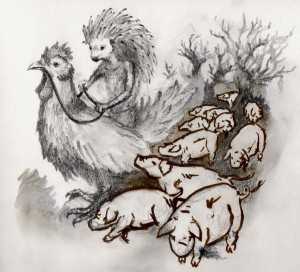I thought it would be fun to start an occasional series of blog posts about some of my favourite fairy stories and folk tales. I’ll find a link to somewhere you can read a particular story online, write up a few thoughts and post some drawings to go with it. When I’ve done enough, and if I can get my head round the copyright of it, I might post the entire stories on their own pages on this site, with the pictures as illustrations.
So where to begin, when there are thousands to choose from? My all-time favourite fairy story is Hans-My-Hedgehog, collected by the Brothers Grimm, so I’m going to start with that. You can read a version of the story here.
This is a story about a boy who is born half-human and half-hedgehog. His conception comes about thanks to some ill-advised wishing on the part of his parents. Unable to conceive naturally and desperate for a child, they declare they’d be happy with a baby made of anything, even if he were made out of a hedgehog.
I first came across this as a kid, thanks to the frankly perfect Jim Henson produced, Anthony Minghella scripted, John Hurt acted, The Storyteller. Minghella’s screenplay is incredible, and the best line of the entire series comes in Hans-My-Hedgehog, when the Storyteller is commenting on the nature of Hans’s birth: ‘As everybody knows, it’s the saying I don’t care what gets you jiggered.’
When Hans becomes aware of his ugliness and his strangeness, he leaves the village of his parents and goes into self-imposed exile in the forest. My favourite image from the entire story is Hans as he rides away from his parents’ house, into the woods. He doesn’t ride a horse, he rides a cockerel that the village blacksmith has shod with iron shoes. Whether the cockerel is giant-sized or Hans is, in fact, the size of a hedgehog, is up to you as the reader. For me, images like this are what fairy stories are all about. Most fairy story plots are a jumble of stock plot points. The neatly arranged narratives of Disney et al are very contemporary developments (a lot of people hate those, but personally I think the sanitised Disney and Disney-esque fairy stories are really interesting – albeit not quite as interesting as the originals). In the same way, fairy stories aren’t much about character, either. Characters are as stock as the things that they do. But both character and plot work very efficiently to deliver us some amazing, original images.
Minghella made Hans a sympathetic character, but in the original Brothers Grimm version he does something horrible and violent to a princess, near the end of the story. He’s a monster as much as he is a hero, and although the Grimms seem to have cast what he does as come-uppance to the princess for breaking a promise, this seems like a very typical Grimm interjection to me. Their stories are occasionally interrupted by very authorial comments explaining how such-and-such a princess was a jolly decent sort really, but the Grimms are now known to have squeezed this sort of thing into the more ambiguous material they had collected. They were doing some of the same things back then as Disney are doing today, only back then the agenda was (even more) sexist and patriarchal. I suppose it’s inevitable that, if the stories are being packaged for children, people will want to add some sort of instructive lesson or meaning, but personally I find I don’t get much out of fairy stories by trying to read them as parables and fables. The raw matter of the stories always seems to be trying to shake off the rules of morality tales, to simply exist on its own as a collection of visual ideas. It is, if you like, the wrong-sized foot being forced into the slipper.
One of the other striking visuals from Hans-My-Hedgehog is the skin-burning that takes place at the end. Like a lot of fairy story beast-kings, Hans is eventually turned into a handsome prince. He achieves this by shedding his skin and having it thrown into a fire by the princess. But when the skin goes up in flames, so does Hans himself. He survives the experience and is later nursed free of his burns, but the image is brillantly savage, and brings to mind ideas of hellfire and redemption and spontaneous combustion. I can’t honestly say for certain why it sticks with me like it does, or why I occasionally find myself picturing with a smile hedgehogs riding on roosters, but I find there’s more to chew on in those images than any moral-at the-end-of-the-story rubbish. And on that note, I’ll finish this little ramble with a picture and the last sentence of the version of the story I have at home (the Jack Zipes, Vintage Classics translation, if you’re interested). It’s different from the version I linked to above, but equally as baffling:
‘My tale is done / And now it’s on the run.’





Hey Ali,
Great Illustrations.
Regarding copyright, I think you’ll find that works become public domain 50 years after they were first published so you can do whatever you want with them, otherwise you’ll need authors/publishers permission.
I’ve got some great ideas for the girl with glass feet for 50 years time… “Midas vs the giant glass lady-robot of death” here we come!
Pingback: Ali Shaw’s Blog - Poor Hans